Meaning of the Triangle Symbol Across Cultures
The triangle symbol embodies deep historical, cultural, and philosophical significance. Historically, it represents stability and harmony, revered by ancient civilizations like the Egyptians and Greeks.
Culturally, it symbolizes interconnectedness in Celtic knotworks and sacred mountains in Mesoamerican traditions. Theologically, the triangle is central to Christian and Egyptian beliefs, symbolizing divine trinity and cosmic order.
In alchemy, triangles denote elemental forces—fire, water, air, and earth. Mathematically, it underpins geometry and calculations involving angles and areas.
Modern design also leverages triangles for their aesthetic and structural properties. Exploring further reveals intricate layers of meaning and application across these domains.

Key Takeaways
- The triangle symbolizes stability, harmony, and interconnectedness.
- In Christian theology, it represents the Holy Trinity.
- Alchemically, an upward triangle signifies fire, and a downward triangle denotes water.
- It is fundamental in geometry and trigonometry for understanding spatial relationships.
- Used in modern design for visual interest and structural stability.
Historical Significance
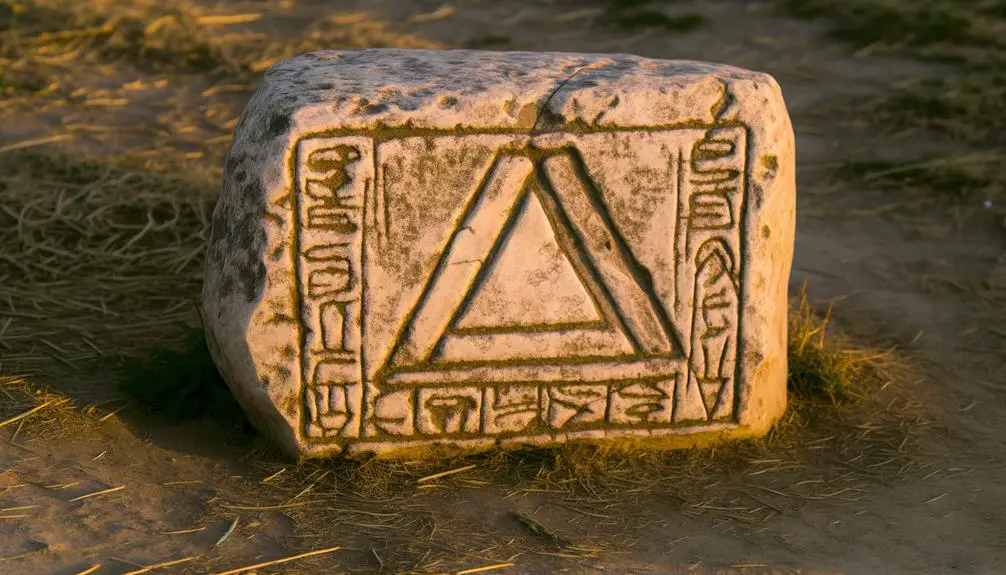
Throughout history, the triangle symbol has held profound significance across various cultures and civilizations, often representing concepts of stability, harmony, and the interconnectedness of elements.
Its three sides and angles have been interpreted to embody a range of philosophical and metaphysical ideas. In geometry, the triangle is the simplest polygon, illustrating the foundational principle of unity within diversity.
The Pythagoreans revered it for its mathematical properties, while alchemists saw it as a symbol of the elemental trinity: air, earth, and water.
In religious contexts, the triangle often signifies the divine triad, such as the Christian Holy Trinity. Its enduring presence in iconography and symbolism underscores its universal appeal and timeless relevance in human thought and spirituality.
Triangles in Ancient Cultures
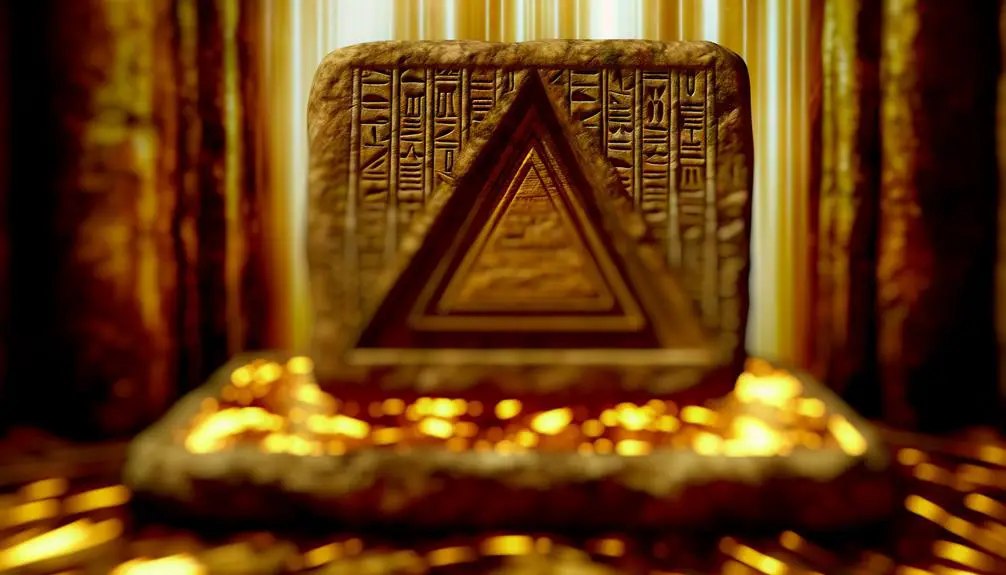
How did ancient cultures interpret the triangle symbol in their art, architecture, and spiritual practices?
In ancient Egypt, the triangle was emblematic of the pyramids, symbolizing strength, eternity, and the connection between the earthly and the divine.
The Greeks revered the triangle for its mathematical perfection and geometric harmony, often seen in their architectural proportions and artistic compositions.
In Mesoamerican cultures, the triangle was integral to their cosmology, representing sacred mountains and the axis mundi.
Additionally, triangles were embedded in Celtic knotwork, symbolizing the interconnectedness of life, death, and rebirth.
Each culture, while distinct, utilized the triangle to convey profound philosophical and metaphysical principles, reflecting its universal significance across various ancient societies.
Religious Interpretations

The triangle symbol holds profound significance in various religious contexts. In Christian theology, it represents the Holy Trinity, embodying the unity of Father, Son, and Holy Spirit.
In contrast, ancient Egyptian beliefs imbued the triangle with connotations of cosmic order and divine harmony. It was often linked to pyramidal structures that symbolized the connection between the earthly and the divine.
These interpretations highlight the triangle's multifaceted role as a symbol of spiritual and metaphysical truths in diverse religious traditions.
Holy Trinity Symbolism
In Christian theology, the triangle is profoundly emblematic of the Holy Trinity, encapsulating the unity and co-equality of the Father, the Son, and the Holy Spirit. Each side of the triangle represents one of the divine persons, yet together they form a single, unified shape, symbolizing the indivisible nature of God. This geometric representation underscores complex theological concepts, illustrating how three distinct entities coexist in a single essence.
| Aspect | Explanation |
|---|---|
| Father | Creator and sustainer of the universe, representing omnipotence and the source of all creation. |
| Son | Jesus Christ, the incarnation of God on Earth, symbolizing sacrifice, redemption, and divine love. |
| Holy Spirit | The presence of God in the world and within believers, embodying guidance, inspiration, and sanctification. |
| Unity | The three distinct persons are not separate but are one in essence and purpose, reflecting perfect harmony and co-equality. |
| Co-equality | Each person of the Trinity is fully God, sharing the same divine nature and attributes, emphasizing the doctrine of consubstantiality. |
This symbolism offers a profound understanding of the intertwined and seamless nature of the Holy Trinity.
Ancient Egyptian Beliefs
Ancient Egyptian religious interpretations of the triangle symbol often centered around its representation of the divine triad, reflecting the interconnectedness of gods, nature, and cosmic order in their theology.
This triadic structure is prominently seen in the deities Osiris, Isis, and Horus, symbolizing death, rebirth, and kingship, respectively.
The triangle's three sides and corners encapsulate the balance of creation, preservation, and destruction—essential principles in Egyptian cosmology.
Additionally, the pyramidal shape, fundamentally a triangle in three dimensions, underscores the ascent towards divinity and the afterlife.
Therefore, the triangle was not merely a geometric figure but a profound emblem of the Egyptians' spiritual and metaphysical beliefs, illustrating the harmony and cyclical nature inherent in their worldview.
Alchemical Symbols
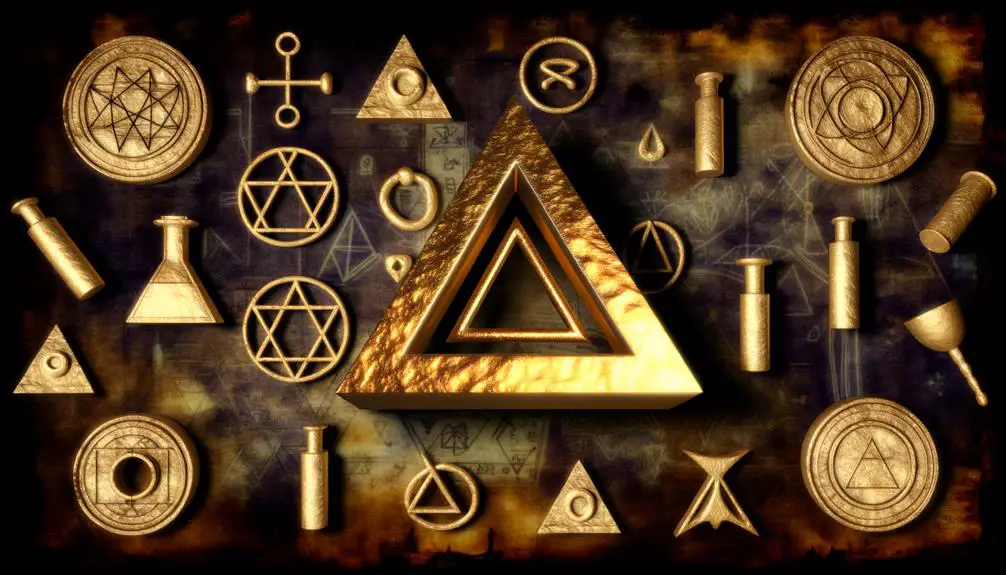
Rooted in the rich traditions of early chemistry and mysticism, alchemical symbols often utilize the triangle to represent the classical elements fundamental to alchemical practices.
The upward-pointing triangle signifies fire, emblematic of transformation and energy.
Conversely, the downward-pointing triangle denotes water, symbolizing purification and intuition.
When a horizontal line bisects these triangles, they represent air (upward triangle with a line) and earth (downward triangle with a line), embodying intellect and stability, respectively.
These geometric representations underscore the alchemists' quest to understand the material and spiritual essence of the universe.
Mathematical Importance
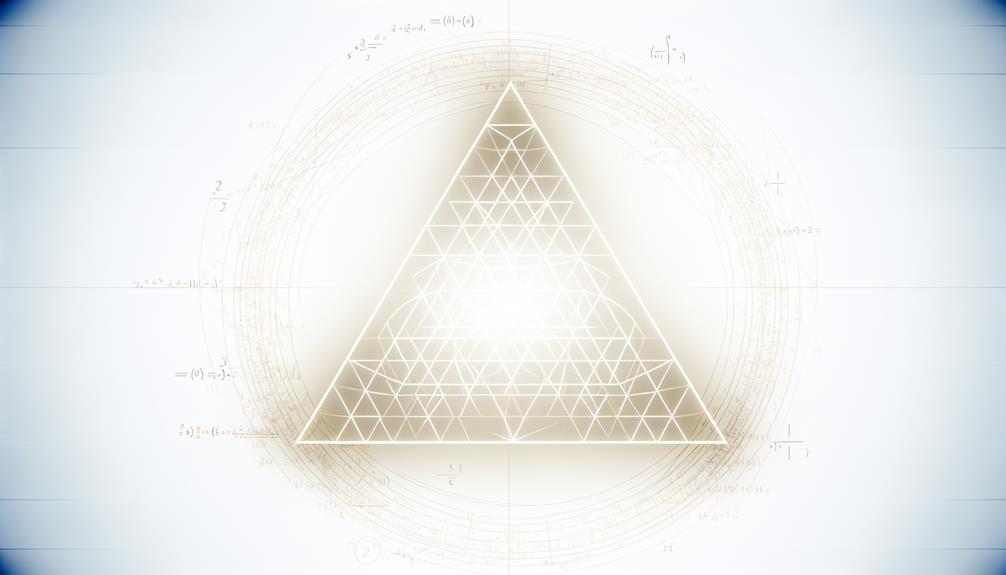
While alchemical symbols imbue the triangle with mystical significance, its mathematical importance is equally profound, underpinning various branches of geometry and trigonometry.
Triangles serve as the foundation for numerous theorems and properties. In Euclidean geometry, triangles are pivotal for understanding the relationships between angles and sides.
In trigonometry, they facilitate the study of periodic functions and oscillations.
Key mathematical concepts involving triangles include:
- Pythagorean Theorem: This fundamental principle relates the lengths of the sides in right-angled triangles.
- Law of Sines and Cosines: These laws are essential for solving triangles in navigation and physics.
- Area Calculations: Triangles provide methods to compute areas of various polygons and complex shapes.
Thus, the triangle is indispensable in mathematical analysis and problem-solving.
Triangles in Art
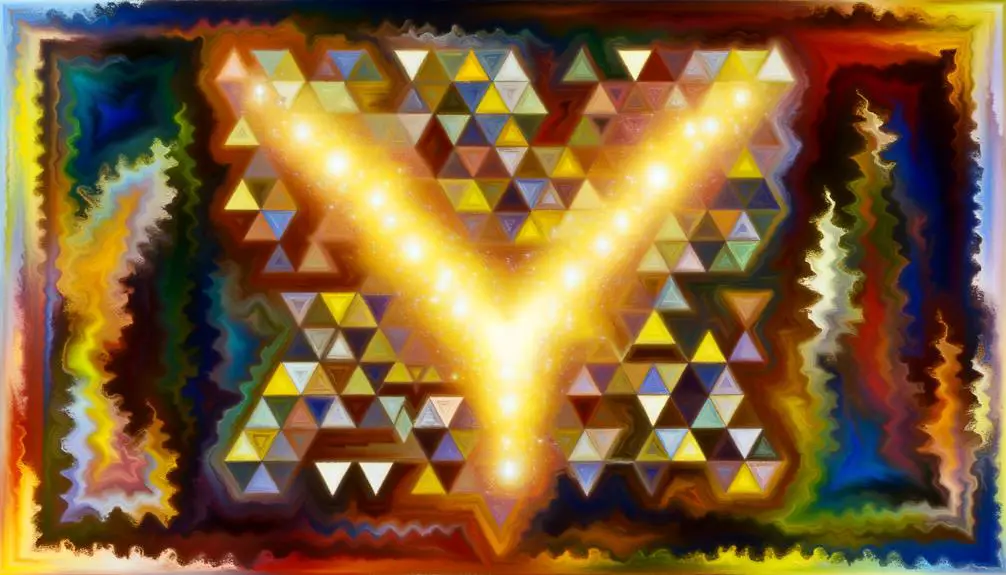
How have artists throughout history harnessed the geometric simplicity and structural stability of triangles to create visually compelling and symbolically rich works of art? Triangles have been a cornerstone in artistic compositions, symbolizing balance, harmony, and strength. From the Renaissance to Modernism, artists utilized triangles to guide viewers' eyes and imbue their works with deeper meaning. During the Renaissance, triangular compositions, known as pyramidal compositions, were prevalent, offering a stable and balanced visual experience. Modern artists like Wassily Kandinsky explored abstract forms, incorporating triangles to evoke dynamic movement and emotional resonance.
| Art Movement | Use of Triangles |
|---|---|
| Renaissance | Pyramidal compositions for stability |
| Baroque | Dramatic triangular forms |
| Cubism | Fragmentation using triangular shapes |
| Modernism | Abstract and dynamic compositions |
| Contemporary | Symbolic and structural elements |
Triangles continue to be a potent tool in artists' repertoires, merging aesthetic appeal with profound symbolism.
Spiritual Meanings
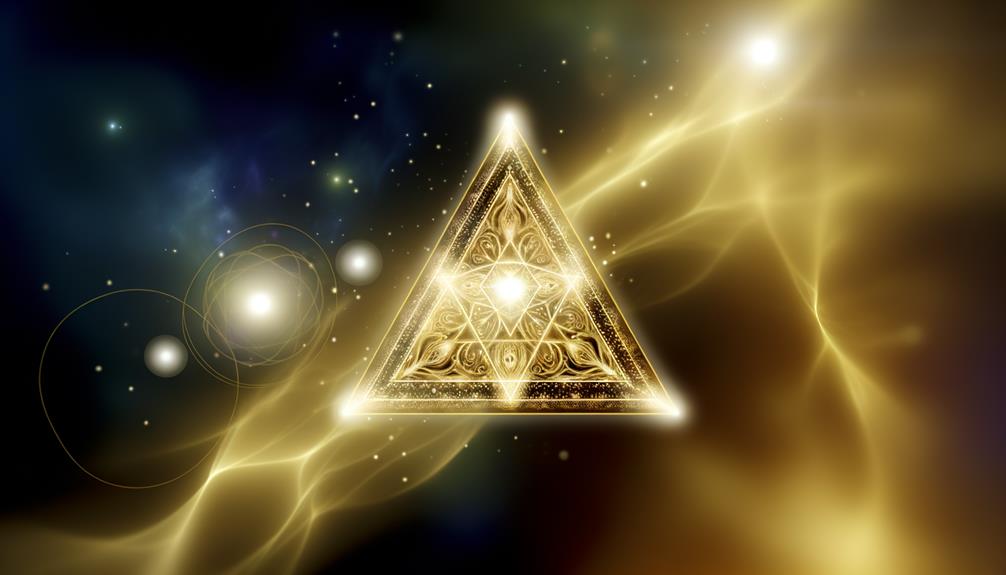
The triangle, often regarded as a powerful symbol in various spiritual traditions, embodies concepts of divinity, enlightenment, and the interconnectedness of mind, body, and spirit. This geometric shape is revered for its profound meanings across multiple cultures and religious beliefs.
Divinity: In Christianity, the triangle represents the Holy Trinity—Father, Son, and Holy Spirit—illustrating the unity and coequality of the divine.
Enlightenment: In Hinduism, the upward-pointing triangle signifies spiritual aspiration and the pursuit of higher knowledge, akin to the rising of the Kundalini energy.
Interconnectedness: The triangle's three sides symbolize the seamless integration of mind, body, and spirit, reflecting a balanced and holistic approach to spiritual well-being.
Thus, the triangle serves as a multifaceted spiritual emblem.
Psychological Perspectives
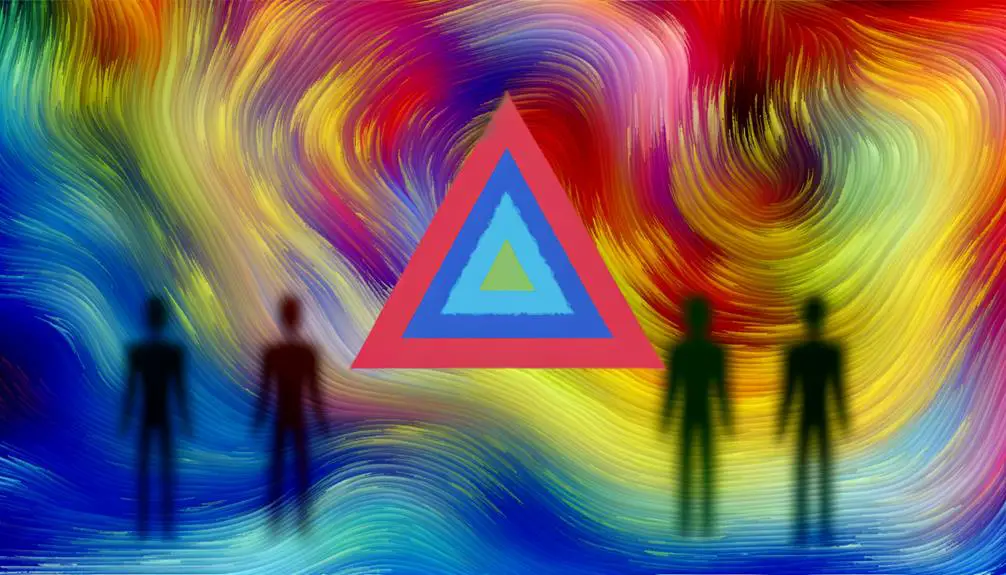
Beyond its spiritual connotations, the triangle also holds significant psychological implications, influencing human perception, cognition, and emotional responses in various profound ways.
Triangles are often perceived as dynamic and directional, guiding the viewer's gaze and attention. This geometric shape evokes a sense of stability and balance when oriented with its base at the bottom, while an inverted triangle can induce feelings of tension or instability.
In cognitive psychology, triangles are recognized for their role in visual organization, aiding in the segmentation of complex scenes into simpler, more manageable parts.
Additionally, the triangle's sharp angles and points can evoke alertness and intensity, impacting emotional states. Understanding these psychological aspects reveals the triangle's profound impact on human experience and interpretation.
Modern Design Uses

In contemporary design, the triangle is employed as a versatile and impactful element, harnessing its geometric precision to create visual interest, structural integrity, and symbolic meaning across various mediums. This shape's appeal in modern aesthetics can be attributed to several key factors:
- Minimalism: Triangles provide a clean, simple form that is central to minimalist design, offering a stark contrast to more complex shapes.
- Dynamic Composition: The triangle's angularity introduces movement and directionality, making compositions more engaging and energetic.
- Structural Applications: In architecture and engineering, triangles are foundational due to their inherent strength and stability, forming the basis of trusses and frameworks.
Symbolism in Literature

Within the domain of literature, the triangle often emerges as a potent symbol, embodying themes of balance, conflict, and transformation. This geometric figure, with its three interconnected points, frequently represents the dynamic interplay between elements such as mind, body, and spirit, or past, present, and future.
Authors employ the triangle to illustrate complex relationships and power structures, where each point signifies a distinct yet interdependent entity. In narratives, the triangle can denote love triangles, highlighting emotional tension and moral dilemmas. Additionally, it may symbolize personal growth, as characters navigate the transformative journey from one point to another.
Through its multifaceted representation, the triangle enriches literary works by providing a nuanced framework for exploring human experiences and existential themes.
Conclusion
The triangle, a symbol whose significance spans ancient cultures, religious doctrines, alchemical traditions, mathematical theories, spiritual beliefs, psychological interpretations, modern design, and literary symbolism, embodies a multifaceted legacy akin to the Pythagorean theorem.
Its enduring presence across various domains underscores its profound and universal appeal, reflecting an archetypal essence that resonates deeply within the human psyche.
In the confluence of these diverse interpretations, the triangle emerges as a timeless emblem of interconnectedness and balance.





